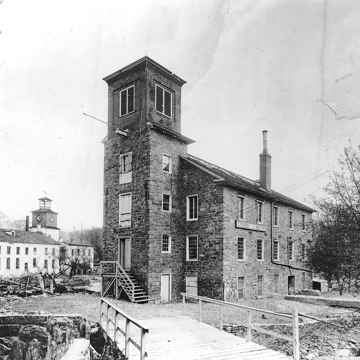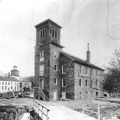Beloved of artists, the brick-and-stone mill occupies one of Delaware's most picturesque settings. When the embargo on British goods initiated during the War of 1812 stimulated the U.S. textile industry (see Henry Clay Mill, CH15.2), Wilmington lawyer Louis McLane and his brother-in-law George Milligan erected the cotton-spinning mill on the Brandywine's west bank. Two pencil sketches by the visiting Benjamin Henry Latrobe, dated October 1813, show “Milligan and McLane's New Mills” without its present tower and with a clerestory roof. William Breck took charge in 1832 but sold out to Charles I. du Pont seven years later, who converted the mill to woolen cloth manufacturing and rebuilt the interior and roof after an 1848 fire (his house with “C.I.D. 1823” datestone still stands upstream). Operations ceased in 1854, and by the 1890s, the mill served as Hagley Community House for DuPont.
Mirroring Breck's across the dam is white, bell-towered Walker's Mill (1813–1815, Joseph E. Sims), used for various purposes, including making cotton yarn and muslin and Rowan cassimere. Alexis I. du Pont bought it in 1843 and converted it to weaving. Walker's closed as late as 1938. The so-called “Walker's Bank” beside it provided workers' housing and is now one of the few survivors of the scores of such dwellings that climbed the hills here. Along the west shore between Hagley Yard (CH15.1) and Rising Sun Bridge (CH20), of twenty-seven buildings of various kinds shown on a 1902 survey, only five remain. One of the missing is Rokeby Mill (rebuilt 1840) on Pancake Run, approximately where the driveway to Breck's Mill is today. It served as the first DuPont experimental station from 1903 until it burned in 1906. In their heyday, around 1820, Rokeby and Milligan and McLane's Mills together housed 2,300 spindles, ten hand looms, and twenty power looms, and employed seventy-nine workers. Porticoed Rokeby house (1836), home to William Breck, stands on a knoll above Breck's Lane.


















